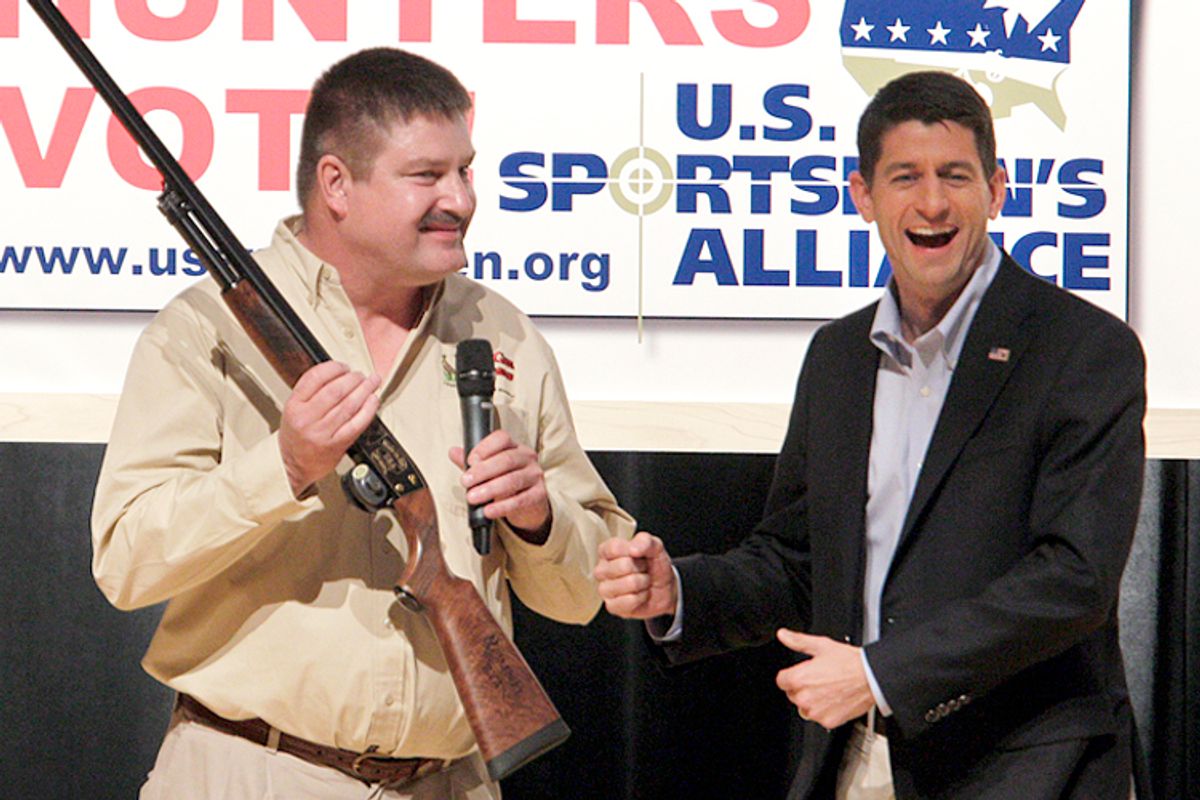When it comes to inspiring audiences to dizzying, irrational fear, right-wing media is especially skillful. Take, for example, the "knockout game" hysteria of last year, in which Fox pundits like Sean Hannity did their best to marshal a handful of disparate cases of real or alleged violence into evidence of widespread, growing, untargeted murderous intent among primarily black teenagers. Was the knockout game ever a rising threat, ever a swelling trend? It now seems unlikely, though the notion that unarmed black teenagers should be seen as de facto lethal coincided rather curiously with Fox’s banner-waving over the verdict in the Trayvon Martin case. Whatever the source, the right-wing media narrative surrounding the knockout game proved that the intentional generation of fear is a tactic far-right media is comfortable engaging in, and the performance of similar tactics in real life should be understood to have similar political purposes.
The "open carry" movement is one such tactic. Weekly, it seems, new cells of gunslingers take it upon themselves to disturb order and intimidate innocent civilians in order to establish a nebulous, rotating series of political aims. A Richmond iteration of open-carrying young men stated they wanted to “raise awareness of responsible gun ownership,” as though the population of Virginia were somehow wholesale unaware of guns. In Arlington, Texas, the open carry commandos who valiantly terrified the staff of a Jack-in-the-Box claimed they merely wanted to “make it as normal as possible for people to see a gun like a fashion accessory … this is America.” In every instance of open carry demonstrations there are two constants: some kind of constitutional concern mashed together with a host of other orthogonal aims, and a roundly frightened public.
Meditate for a moment on the notion of making people comfortable with the sight of guns in public via habituating them to the instinctual terror of seeing one, and two issues immediately arise: firstly, it resembles other illogical forms of activism in which the goal is wholly incompatible with the means, such as murdering abortion providers to achieve a culture of life; secondly, it is, above all else, an effort at achieving control.
After all, it isn’t as though the advocates of openly carrying guns in public are unaware of the effect they have on the public; they are usually met with resistance precisely because they terrify innocent bystanders, while their constitutional concerns – such as they are – tend to be swallowed up by the technique of their "protest." It is rather the case that they claim the period of fear they deliberately inspire is one they intend to force the public to endure until they are no longer met with resistance. If their narrative is to be thought genuine, then their intention is literally to forcibly habituate the public to the idea that they are constantly in danger, and that there is little that can be done about it. Or, as Open Carry Texas puts it, the goal is to: “condition Texans to feel safe around law-abiding citizens that choose to carry [guns].” Of course, the fact that they are willing to inflict terror to achieve, bizarrely, a sense of safety demonstrates that people feeling safe isn’t really a goal here; otherwise pictures of guns or speech campaigns would surely suffice. The fear is, in other words, intentional.
So the question that remains is: Do you really believe that anyone expects guns will ever not be alarming? With mass shootings taking on an increasingly public and random character, guns appearing at random in public should be a cause for alarm. And, so long as media coverage of mass shootings persists, it seems unlikely that the toting of firearms in public will ever actually cease to inspire unrest in onlookers. (Not that there is any shortage of reasons to be wary of guns even if the gunslinger himself is trusted; guns can be dropped, mishandled, stolen or taken from their "trustworthy" carriers at any time.)
For those reasons it seems doubtful that large-scale conditioning is possible or even genuinely intended. Rather, the decision to forcibly condition a population that did not consent to or request to be so habituated likely reflects more truthfully on the intended political outcome. To attempt to condition a set of people is to attempt to assert control over their thoughts, reactions, behaviors, even beliefs – and this is a stated goal, albeit one that is unlikely to come to fruition. Regardless, it demonstrates a dedication to an achievement of control, either experienced or legitimate.
That is, the open carry lobby is about an assertion of power: With the backing of their firearms, they will either change how you think and behave by conditioning or by fear, but in either circumstance the attempt is to manage the surrounding population in some way or another. This is precisely the sort of response you would expect from a culture that lives on the fear-mongering techniques of right-wing media; after all, one response to living in a state of perpetual fear of persecution or attack is to claim the mantle of fearsomeness for oneself. But this is a self-perpetuating cycle of fear and the infliction of fear, and the prize at stake is control. With luck these theatrical demonstrations of power will die down, but each motion of the state to contain them is interpreted as persecution, fueling the spiral.

Shares